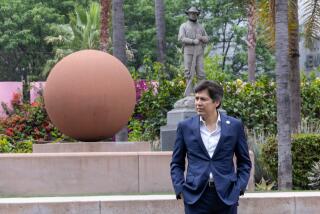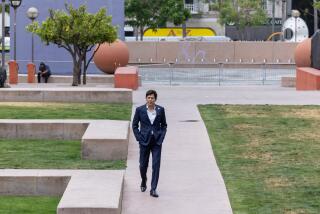A stonecutter carves way to French pride
Makingson Delivrance Mespoulous runs his fingers along a worn-smooth column holding up the roof of the Notre Dame Cathedral that has presided in Gothic splendor over Paris for eight centuries, his face dusted white from stone shavings.
The 34-year-old stone carver has spent the last 11 years restoring the stained-black arches and nose-less gargoyles of some of France’s favorite, but crumbling, monuments. But Mespoulous has spent his entire life carving his way through something else: the barricades created by France’s ethnic divide.
For the record:
11:32 a.m. Dec. 19, 2019In this article, Nespoulous is misspelled as Mespoulous.
Born in Haiti and adopted by a French family when he was 3, Mespoulous knows that his black skin is uncommon among the craftsmen who preserve this nation’s architectural heritage. While he was perched on wind-swept scaffolds, some co-workers had tried to keep his story outside the walls of French history.
“They told me these monuments were not built for me, but for the French. They told me to go home,” he says, able to smile about it now because such blows were rare enough and because after years of back-twisting labor beside fellow artisans, he believes that most are a second family.
This soft-spoken man proved he had the ferocious but controlled energy needed to dig into a gigantic slab of stone at the painstakingly slow rhythm the material demands. Others noticed, and despite his different background, Mespoulous was quickly given the responsibility of overseeing crucial restoration sites in his “village of old stones,” Paris.
“There are not many black stone carvers,” Mespoulous says. “And yet,” he says, speaking of employers, “they come to me, to ask me where I want to work, what I want to do. They let me do whatever I want.”
As he passes monuments covered like badly wrapped presents for reconstruction, Mespoulous repeatedly calls out to friends working behind the plastic curtains. “Eventually, everyone gets along,” he says with a smile.
Carving an entry into France’s past gave Mespoulous a tangible link to a country he didn’t easily fit into as the only child of color in a small village 1 1/2 hours’ drive north of Paris, where he began sculpting rocks from abandoned quarries. Though he was surrounded by a loving family, Mespoulous says he lacked confidence, and adds, “I was a black boy in a white country. No matter what I did, I was different.”
But through the arts, he quickly turned that difference into an asset. No longer yearning to simply blend in, he would “mark this world” and set himself apart. “I wanted to show that I was the Haitian that builds French cathedrals,” he says with pride.
He has even made a secret mark on the stunning Notre Dame. Hidden deep behind the stones of the cathedral is an oil painting of a turquoise-blue galloping horse. Mespoulous buried it there.
He leans forward and whispers: “All these monuments are a little like people’s dreams. . . . I’d like to add my own dream -- a story -- to theirs.”
Emblems of national pride to many, to Mespoulous these Gothic ruins are human fantasies translated into stone. He even feels connected to the Europeans who nearly a millennium ago used basically the same chisel and mallet to do the work he continues. “Just from looking at their work, I can see if the cutter was big or small, strong or a perfectionist,” he says.
His hunched shoulders pinch at the neck, and his eyes widen when he adds, “I know we were thinking about the same things. Just from looking at the direction and size of their marks, I can get an idea of who they were.”
For other minorities, the connections don’t come so easily. Children of immigrants who came here in the last 40 years are less successful at resolving the familiar battle to belong. Many say they “don’t feel French,” an identity crisis that can flare into violence in poorer, immigrant-heavy suburbs, as happened in November and, more massively, two years earlier. Youths with home addresses in those areas or names that sound North or West African (the dominant populations there) have had a harder time getting jobs.
Sociologist Jean-Luc Richard says youths are well integrated in schools, but after graduation “they are faced with discrimination as soon as they want to work.”
Today, the splendor typical of central Paris is a foreign landscape to so many of the immigrants who live a subway ride away. In turn, many lighter-skinned French are afraid to step foot in the unfamiliar suburbs.
Despite discrimination, sociologist and philosopher Jacques Tarnero says history is at the heart of the exclusion felt by second- and third-generation immigrants. Although France gives immigrant youths more freedoms than they would have in Africa, “those freedoms are given to them by the country that colonized their parents,” Tarnero says. “So how does one love -- when we are young -- the country that humiliated your parents?”
For his part, Mespoulous says his “revenge” for the mistreatment of his enslaved ancestors, as well as what he calls a “close-minded way of thinking,” is that he gets “to be a free artist.” But that isn’t quite enough either.
Replacing old stones and inserting sketches into the cracks of French history, Mespoulous is literally grafting his own tale onto an older one.
“Life is hard -- you have to carve into it,” he says. “We have to bring in new ideas and redo what was done a long time ago. We’ve got to break up all of those psychological barriers.”
Between stonecutting gigs, Mespoulous pursues his dream of becoming a great painter. He shares a small apartment with his girlfriend in the poor suburb of Saint-Denis, just north of Paris. It doubles as a makeshift studio, and he comes into the capital whenever possible to peddle his portfolio to occasionally interested galleries.
Although the suburb can feel depressingly empty of the friends he has made in Paris, he feels comfortable living near other people who “also don’t have money.”
But with financial struggles mounting, Mespoulous believes that he may not endure another freezing winter laboring outdoors from dawn until dusk. When he examines his calloused, dusty gray hands, he admits to losing his grip on the old confidence and joy that carving had given him. He had hoped to eke out a living until the weather warmed up by selling his paintings, but by mid-January he was out of cash and joined a restoration crew near the city’s old opera house.
“When my Haitian parents saw my hands, they were upset,” he says, recalling the first time he met his biological parents six years ago. “Being Haitians, they know what hard labor is. They know what slavery is. That’s why they sent me away, so that I wouldn’t have to do that kind of labor. . . . It’s the same kind of work, but this time with honor and glory. I hope.”
More to Read
Sign up for Essential California
The most important California stories and recommendations in your inbox every morning.
You may occasionally receive promotional content from the Los Angeles Times.










